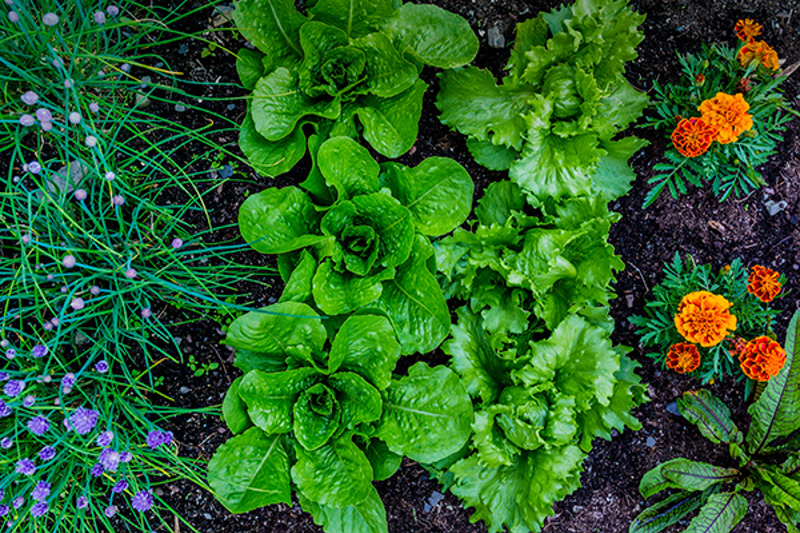Yates Account
Join now
Create a Yates account today!
Sign up to join the Yates Garden Club for monthly e-mails packed with seasonal inspiration, tips for success & exclusive promotions.
Plus if you’re a Garden Club member you can take part in the Yates Growing Community - a blog to share successes, get advice & win prizes in fun challenges along the way!

Forgot password
Enter the email address associated with your account, and we'll email you a new password.
Most gardeners have heard about the benefits of companion planting, but many aren’t sure exactly how to go about it. Companion planting involves grouping particular plants close together so that they help each other to grow better. They can do this in many different ways; read on for a rundown on the benefits of companion planting.
Gardeners have been using companion planting techniques for thousands of years. For example, indigenous peoples in Central and North America practiced the ‘Three Sisters’ technique of planting maize, beans and squash together. The idea is that the three sisters help one another; the maize holds up the climbing beans, the beans share the nitrogen they’ve fixed and the squash leaves shade the ground and help hold on to moisture. So, in a tight group, these vegies do better than they would on their own.

1. Plants that attract beneficial insects
Planting a mixture of flowers and herbs among vegies and fruit trees will encourage a healthy diversity of living creatures to move into the garden. Insect-attracting plants that grow readily from seed include herbs like thyme, sage, coriander, chives and mint, and flowers such as cosmos, calendula, lavender, echinacea and marigold.
For a good mix of pollinator-attracting plants, try Bee Pasture Pollinator Feed Mix and Butterfly Field Beneficial Insect Mix.
The great thing about attracting pollinators is that they’re always accompanied by a range of predator insects. These hungry predators are more than happy to help suppress the insect pests on your vegies.
2. Masking and decoy plants
Masking plants emit a strong odour, that disguises the smell of desirable plants and confuses the insect pests that might otherwise sniff them out and attack them. A good example is planting onions beside carrots to deter carrot rust fly. Likewise, planting chives, onions or garlic near roses helps deter thrips and aphids.
Another technique is to literally hide desirable plants in amongst taller plants, so they can’t be seen by pests. It even works if you tuck your vegies in amongst low groundcover plants, so there isn’t bare soil around the vegies (this approach is actually supported by evidence from field trial studies).
Closely related to the masking plants are the ‘decoy’ plants that attract pests towards themselves and away from their neighbours. Nasturtium is one of the best-known decoy plants. Nasturtiums act like magnets, pulling pests away from nearby vegetables. Plants like this are sometimes called ‘sacrificial’ or ‘martyr’ plants because they’re prepared to suffer in order to protect their companions!
3. Nurturing and protecting plants
Some plants are a great match because they improve conditions for their neighbours. The best-known of these are the peas, beans and other members of the legume family that have the ability to capture nitrogen from the atmosphere. Plants growing in close proximity to peas and beans benefit from the nitrogen the legumes have added to the soil.
Other plants can protect smaller vegies from frost, or from drying out. Corn is a classic example, providing shade for lettuces, rocket and coriander planted around its base, helping them not to bolt to seed.
Then there are plants that actively deter insect pests by producing pungent chemicals. For example, marigolds are packed with limonene, which deters whitefly (it’s believed aphids don’t like the aroma of marigolds either). This explains why tomatoes are traditionally teamed up with marigolds!
4. Choosing companion plants
There are just as many poor matches as there are beneficial ones in companion planting. Some of these are common sense, for example, it’s not a great idea to plant your carrots beside parsnips, parsley, or celery because it doubles the attractiveness of your patch to carrot rust fly. Hide your carrots amongst some smelly onion neighbours instead! For the same reason, don't interplant your potatoes and tomatoes - they're related, so you'll create a magnet for pests.
Other bad matches aren’t so obvious. For example, fennel doesn’t play nicely with its neighbours at all. Surprisingly, the allium family (onions) don’t get along with legumes (peas and beans), so that's one to remember.
Working out which plants grow well together is often a matter of individual trial and error, so don’t be scared to experiment.
Our Yates seed packets usually carry recommendations for herb and vegetable companion planting. Here are some of our favourites:
• Pumpkin loves corn
• Beans adore radishes
• Cabbages worship beans
• Celery is entranced by onions
• Beetroot is enamoured with broccoli
• Lettuce and onions are a match made in heaven














Share
Share this article on social media